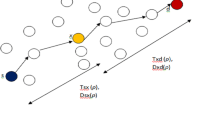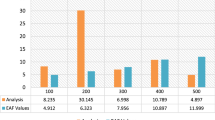Abstract
In wireless sensor networks, some areas often become unavailable due to the exhaustion of nodes’ energy, congestion, or disaster. In this paper, we propose a new micro sensor multi-path routing protocol (MSMRP) to avoid the unavailable areas when constructing the routes. A neighbor node table exchanging mechanism in MSMRP is used to avoid the multiple paths intersect and to build a new route around the unavailable areas. We have implemented the proposed protocol in a network with real sensor nodes and conducted experiments to demonstrate the operation and the capability of the MSMRP. Furthermore, we illustrate the performance of MSMRP comparing to ad hoc on demand multi-path distance vector (AOMDV) routing protocol with NS-2 simulations.
Similar content being viewed by others
References
Tan L., Meng J., Li J., Chao H.-C. (2007) PH-MAC: A periodically hybrid MAC protocol for wireless sensor networks. Journal of Internet Technology 11: 272–280
Fang Q., Gao J., Guibas L. J. (2006) Locating and bypassing holes in sensor networks. Springer Mobile Networks and Applications 2: 187–200
Jafarian, M., & Jaseemuddin, M. (2008). Routing of emergency data in a wireless sensor network for mines. In Proceedings of IEEE international conference on communications (ICC’08) (pp. 2813–2818). Beijing, China.
Jain N., Madathil D. K., Agrawal D. P. (2006) MidHopRoute: A multiple path routing framework for load balancing with service differentiation in wireless sensor networks. International Journal of Ad Hoc and Ubiquitous Computing 1: 210–221
Lee, S.-J., & Gerla, M. (2001). Split multipath routing with maximally disjoint paths in ad hoc networks. In Proceedings of IEEE international conference on communications (ICC’01) (pp. 3201–3205). Helsinki, Finland.
Marina, M., & Das, S. (2001). On-demand multipath distance vector routing in ad hoc networks. In Proceedings of the 9th international conference on network protocols (ICNP’01) (pp. 14–23). California, USA.
Kim M., Jeong E., Bang Y. C., Hwang S., Shin C., Jin G. J., Kim B. (2008) An energy-aware multipath routing algorithm in wireless sensor networks. IEICE Transactions on Information and Systems 10: 2419–2427
Wang H., Poo G.-S. (2007) Load balancing in the provisioning of hose model virtual private networks with multi-path routing. IET Communications 8: 684–692
Chen, Y., & Nasser, N. (2008) Enabling QoS multipath routing protocol for wireless sensor networks. In Proceedings of IEEE international conference on communications (ICC’08) (pp. 2421–2425). Beijing, China.
Toledo, A., & Wang, X. (2006). Efficient multipath in sensor networks using diffusion and network coding. In Proceedings of the 40th annual conference on information sciences and systems (CISS’06) (pp. 87–92). Princeton, NJ.
Teo J.-Y., Ha Y., Tham C.-K. (2008) Interference-minimized multipath routing with congestion control in wireless sensor network for high-rate streaming. IEEE Transactions on Mobile Computing 9: 1124–1137
Aissani, M., Mellouk, A., Badache, N., & Djebbar, M. (2009). A preventive rerouting scheme for avoiding voids in wireless sensor networks. In Proceedings of IEEE global telecommunications conference (GLOBECOM 2009) (pp. 1–5). Hawaii, USA.
Yang, J., & Fei, Z. (2010). HDAR: Hole detection and adaptive geographic routing for ad hoc networks. In Proceedings of the 19th international conference on computer communications and networks (ICCCN 2010) (pp. 1–6). ETH Zurich, Switzerland.
Gao, D., Niu, Y., & Zhang, H. (2009) Micro sensor routing protocol in IPv6 wireless sensor network. In Proceedings of IEEE international conference on networking, sensing and control (ICNSC’09) (pp. 55–59). Okayama, Japan.
Huo, H., Zhang, H., Niu, Y., Gao, S., Li, Z., & Zhang, S. (2006). MSRLab6: An IPv6 wireless sensor networks testbed. In Proceedings of the 8th international conference on signal processing. Guilin, China.
Hui, J. W., & Culler, D. E. (2008) IP is dead, long live IP for wireless sensor networks. In Proceedings of the 6th ACM conference on embedded network sensor systems (SenSys’08) (pp. 5–28). Raleigh, NC, USA.
IETF. IPv6 over low power WPAN (6lowpan) charter. [Online]. Available: http://www.ietf.org/html.charters/6lowpancharter.html.
NS-2 network simulator. [Online]. Available: http://www.isi.edu/nsnam/ns/.
Author information
Authors and Affiliations
Corresponding author
Rights and permissions
About this article
Cite this article
Gao, D., Yang, O., Zhang, H. et al. Multi-Path Routing Protocol with Unavailable Areas Identification in Wireless Sensor Networks. Wireless Pers Commun 60, 443–462 (2011). https://doi.org/10.1007/s11277-011-0301-z
Published:
Issue Date:
DOI: https://doi.org/10.1007/s11277-011-0301-z




